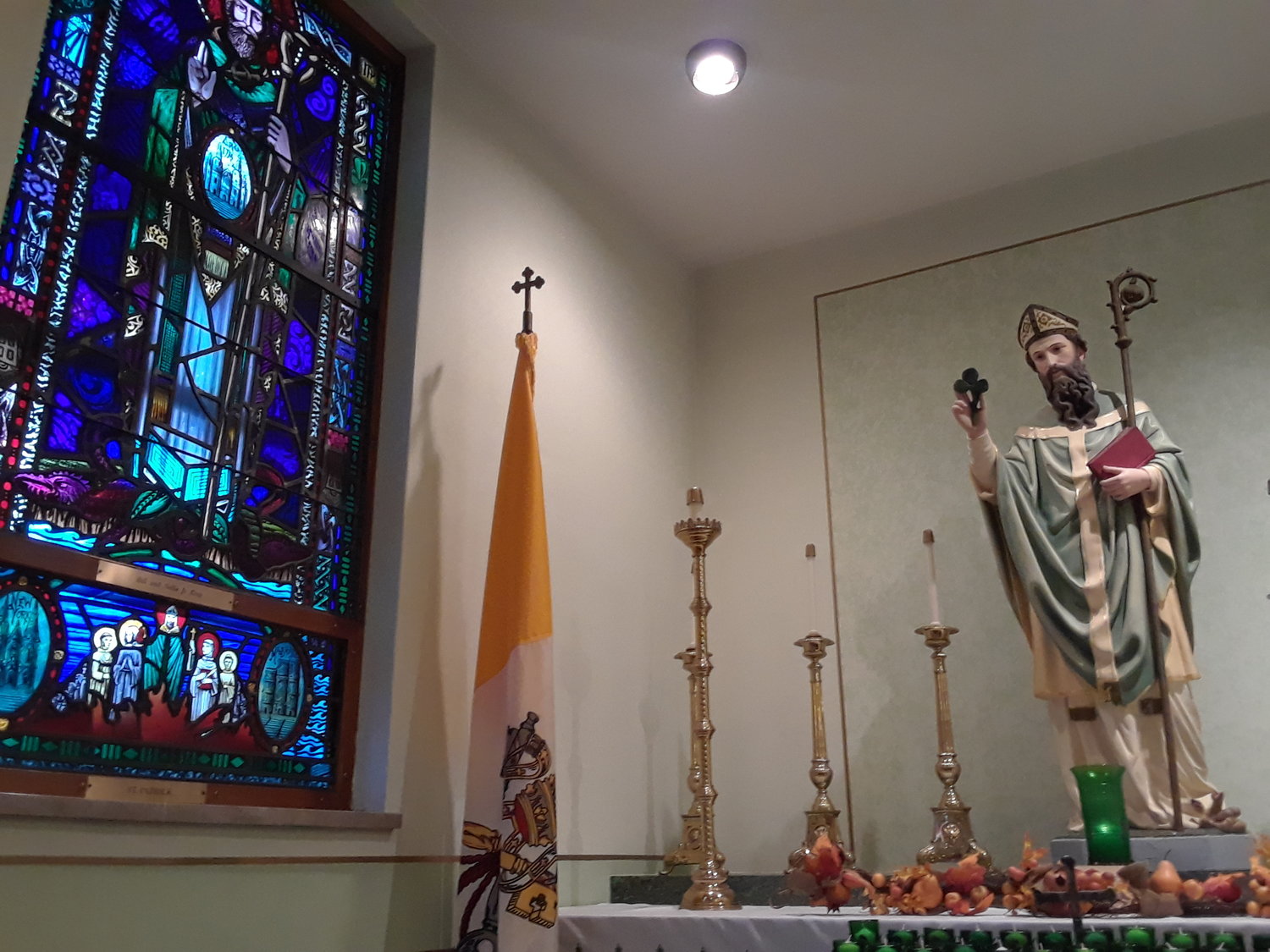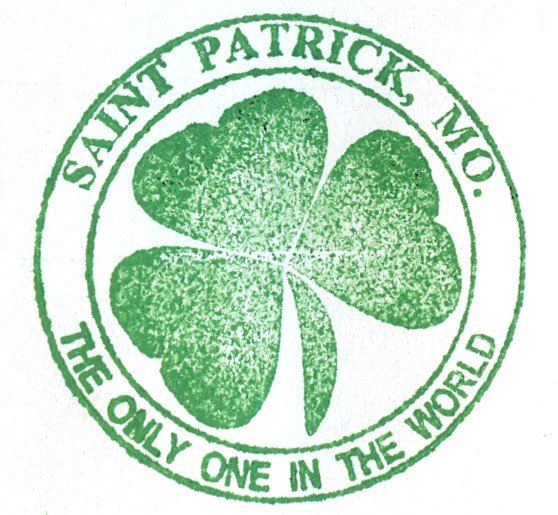Time to celebrate Shrine of St. Patrick’s 65th anniversary
Mass, festivities on Sunday, March 13

The Shrine of St. Patrick in St. Patrick is offering a specially-designed envelope and 2022 pictorial postal cancellation, envelope and prayer insert through March 31.
Both the envelope and the U.S. Postal cancellation are a celebration of Ireland.
A beautiful Celtic cross with a shamrock that is wrapped with trailing ribbon and the words “Erin Go Bragh,” which is Gaelic for “Ireland forever.”
The Irish greeting on the prayer insert, which also has the Celtic cross, harkens back to the “Old Sod,” with Irish blessings and Irish good luck wishes.
The greeting-card-sized envelope can be purchased for $2.25 each and include the envelope, Irish greeting insert, postage, and the special Cachet stamping of “St. Patrick, Mo. The Only One In The World.”
The greeting card can also be inscribed for the sender by the Shrine of St. Patrick volunteers and also be mailed on the date of the sender’s choosing, between now and March 31.
“By sending your mailing list to The Shrine of St. Patrick, P.O. Box 34, St. Patrick, Mo. 63466, the Shrine volunteers will prepare your envelopes per your wishes and apply the special Cachet stamping,” volunteers stated. “They will then deliver them to the St. Patrick Post Office for the Special Pictorial Cancellation and mailing.”
SCROLL THE ARROWS to see two more photos.
Shrine of St. Patrick Parish in St. Patrick will celebrate the 65th anniversary of the completion of the shrine during its annual St. Patrick’s Day celebration on Sunday, March 13.
Father Rob Fields, pastor, will celebrate Mass at 8 a.m. in the shrine, located at 2 Erin Circle, off of State Highway 81 in Clark County.
Following Mass, the parish’s 2022 Historical Preservation Award will be presented to Franciscan Father James Wheeler of Quincy, Illinois, and posthumously to Franciscan Sister Mary Eleanor Dunning (1922-2011); Sr. M. Veronica Ellison of the Franciscan Sisters of the Poor (1912-2000); Franciscan Sister Agnes Clare Henderson (1910-2006) and Franciscan Sister Pauline Logsdon (1923-2019).
All five grew up as members of Shrine of St. Patrick Parish.
“The Catholic Church has always been the center of the St. Patrick community and inspired these individuals to give their lives in service to God,” the event’s organizers noted in a statement.
After Mass, a roast beef and ham dinner will be available from 10:30 a.m. to 1:30 p.m. There will also be a Silent Auction, 50/50 Raffle and Children’s Cake Walk.
The 2022 Special Pictorial Cancellation and Envelope is also available for purchase that day, with the historical “St. Patrick, Mo. The Only One In The World” Cachet Stamp and the special pictorial postal cancellation.
Humble origin
Far away yet close, as the past and present become one in the Communion of Saints and the Holy Sacrifice of the Mass, Monsignor Francis O’Duignan (1901-91) and past parishioners will join in the eternal hymns of praise.
It was their prayers and hard work that after 22 years yielded a shrine suitable for God’s glory and the memory of a fifth-century missionary who had convinced the warring chieftains of an island called Erin to submit to the will of the One and Triune God.
Msgr. O’Duignan, a native of Longford, Ireland, who had come to the United States as a priest of the former Diocese of St. Joseph, Missouri, was appointed pastor of St. Patrick Parish in 1935.
According to legend, he entered and left the town by horse and carriage before realizing that he had arrived.
He became shepherd of a century-old Catholic community dating from the arrival of Richard and Rose (Simpson) Riney and several members of their families in 1833.
Bishop Joseph Rosati, CM of St. Louis bought the present parish property in 1838.
Irish-born Father Bernard P. McMenomy in 1854 sold 10 acres of the property for the development of a town, which he named St. Marysville. He later renamed the town St. Patrick.
When a post office was established there, it became the only post office in the world to be named for St. Patrick — a distinction it still proudly holds.
A substantial brick church, built in 1860, was sagging under its own weight by 1903, when parishioners built a simpler church on the same site.
Grand designs
Msgr. O’Duignan became convinced that the people of St. Patrick could do much, much better if they set their minds and hearts to it.
The parishioners were poor farmers weathering the Great Depression. His first Sunday collection was $1.72. If the town and parish of St. Patrick were to live up to the legacy of their namesake — whose missionary endeavors and subsequent intercession have drawn millions upon millions to the faith — they would need some help.
“Next to St. Paul, St. Patrick was the Church’s greatest missionary,” Msgr. O’Duignan told The Catholic Missourian in 1974.
As pastor, Msgr. O’Duignan started the parish’s annual Novena to St. Patrick from March 9-17.
In 1936, the priest designed a shamrock cachet, or official seal, and affixed it to 500 letters requesting donations toward building a shrine. He mailed the letters all over the country, bearing the March 17 St. Patrick postmark.
He wanted the shrine not only to honor St. Patrick but also the United States, for welcoming so many immigrants.
Over the years, he recruited young parishioners — specifically typing students at the old parish high school — to search telephone directories and address letters to people with Irish surnames.
He mailed thousands of letters each year, and wrote a personal thank-you note for every donation, large or small.
Letters bearing the distinctive cachet and St. Patrick cancellation became sought-after items among stamp collectors and Ireland’s dispersed sons and daughters. People began sending donations and requesting some special mail.
Msgr. O’Duignan never disappointed them.
Promise fulfilled
After two decades of calling upon people of many creeds, nationalities and means in the United States and Ireland, Msgr. O’Duignan finally had enough money to begin the new shrine.
It would be a stone bridge between ancient Celtic architecture and the emerging mid-century simplicity of American church design.
Buff-colored stones slowly rose into the shape of an Irish monastery, complete with a tapered, circular bell tower, recessed arches, Celtic crosses, and panes of detailed stained glass, scattering emerald images across the 300-seat, marble-clad interior.
Thirty-seven stained glass windows depicting Gospel heroes and Irish saints were designed and made in Dublin, Ireland. They cost $500 apiece, including shipping.
The rose window above the choir loft depicts symbols of Ireland’s four provinces.
A stone mason in Hamilton, Illinois, made the altars from green and dark pink Italian marble, quarried from the top of a mountain.
The marble for the communion rail came from Spain.
A relic of St. Patrick was laid to rest in the altar, a piece of Damhliag Mor in Armagh, St. Patrick’s episcopal headquarters, was embedded in the floor before the sparkling new altar.
Msgr. O’Duignan celebrated the first Mass in the shrine in the autumn of 1956.
Bishop Joseph M. Marling C.PP.S., founding bishop of Jefferson City, dedicated the shrine on March 17, 1957.
Joining him at the altar was Bishop Charles LeBlond, who had recently retired as bishop of St. Joseph.
Newspapers reported that 10,000 people attended the dedication, spilling out the door into the churchyard.
A pilot flew a plane called the Spirit of Ireland over the shrine and dropped thousands of shamrocks.
Bishop Marling echoed Msgr. O’Duignan’s conviction that the shrine would be a tool through which Christ would draw parishioners and visitors closer to Himself, through the sacraments and contemplation of the lives of His holy servants.
Out on mission
Obedient to his bishop, the longtime pastor reluctantly accepted a new parish assignment in the summer of 1957, only a few months after the shrine was completed.
He later served as pastor of what would become Cathedral of St. Joseph Parish in Jefferson City.
He also worked to build up the Church and plan for the future. He and Bishop Marling — himself of Irish descent — made several trips to Ireland, speaking to young men about the desperate need for priests in central and northeastern Missouri, and to young women about the need for religious sisters.
Many heard the call and answered it.
“We, presently living in the diocese owe a great deal of thanks to our first bishop, the late Joseph M. Marling, and to Monsignor Francis O’Duignan,” the late Bishop Michael F. McAuliffe, the diocese’s second bishop, wrote in 1989.
Historical information in this article came from “History of St. Patrick, Mo., 1833-1989,” by Ellen Krueger, the St. Patrick, Missouri Facebook page, and past articles in The Catholic Missourian.
Comments
Other items that may interest you
Services
The Catholic
Missourian
2207 W. Main St.
Jefferson City MO 65109-0914
(573) 635-9127
editor@diojeffcity.org







